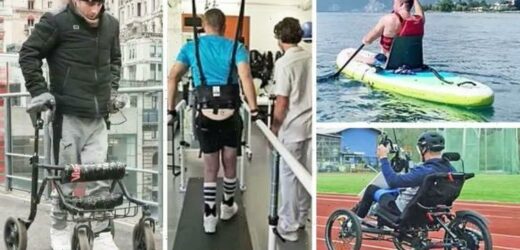Paraplegic men fitted with revolutionary spinal cord implant
We use your sign-up to provide content in ways you’ve consented to and to improve our understanding of you. This may include adverts from us and 3rd parties based on our understanding. You can unsubscribe at any time. More info
Italian-born Michel Roccati, 29, has become the first person in the world to be able to walk freely despite having a complete cut to the spinal cord. He joins a number of others who are being given a lifeline thanks to incredible research at the Swiss Federal Institute of Technology in Lausanne. Patients have been able to walk, swim and cycle thanks to their device which works by stimulating the region of the spinal cord that activates the trunk and leg muscles.
The technology uses artificial intelligence (AI) to reactivate neurons via a pacemaker inserted in the patient’s abdomen.
Mr Roccati, who had been confirmed to a wheelchair for over four years following a motorbike crash, joined two others in testing the implant.
He said: “The first few steps were incredible — a dream come true.
“I’ve been through some pretty intense training in the past few months and I’ve set myself a series of goals.


“For instance, I can now go up and down stairs and I hope to be able to walk one kilometre (0.62 miles) by this spring.”
The device is not meant to be a cure for spinal injury and is still too complicated to be used in everyday life.
But, nonetheless, it provides a glimmer of hope for those told they will never walk again.
Project leader Professor Gregoire Courtine, said: “Our new, soft implanted leads are designed to be placed underneath the vertebrae, directly on the spinal cord.
“They can modulate the neurons regulating specific muscle groups.

“By controlling these implants, we can activate the spinal cord like the brain would do naturally to have the patient stand, walk, swim or ride a bike, for example.”
Nerves in the spinal cord send signals from the brain to the legs.
Some people are paralysed when the nerves are damaged through injury.
Co-project leader Professor Jocelyne Bloch, a neuroscientist at Lausanne University Hospital, said: “Our breakthrough here is the longer, wider implanted leads with electrodes.
“They are arranged in a way that corresponds exactly to the spinal nerve roots.
DON’T MISS:
Sea level rise crisis as UK expert warns: ‘Not if, when!’ [SPOTLIGHT]
Archaeologists left horrified by grim Roman-era burial [REVEAL]
UK primed to replace Russia as EU’s main energy importer [INSIGHT]


“That gives us precise control over the neurons regulating specific muscles.”
A total of three patients were involved in the study and they underwent extensive training to get comfortable with the technology.
Prof Courtine said: “Patients can select the desired activity on the tablet and the corresponding protocols are relayed to the pacemaker in the abdomen.”
The expert was blown away by the “astonishing” progress made after just one day and said after several months even more can be achieved.
At the moment, the implant uses just 16 electrodes to stimulate the nerves, but in time, the researchers want to move to 32 or 64 to gain even greater control.
The team is now working to move their technology to a smartphone, so patients can simply select the activity they want to carry out.
Their research has been published in the journal Nature Medicine.
Source: Read Full Article


